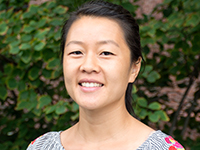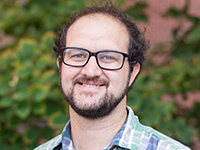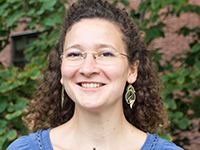The educational backgrounds of Harvard MCB postdocs run the gamut from physician to data scientist to electrical engineer, each bringing a unique expertise to the community.
This fall, five postdocs received prestigious fellowships in support of their research. Jeffrey Moore of the Dulac Lab and Nicholas Tran of the Sanes Lab earned “Pathway To Independence” Awards from the NIH, Athar Malik of the Uchida lab was chosen as a recipient of the R25 fellowship for physician-scientists-in-training from NINDS, and new arrivals Jenny Chen of the Hoekstra Lab and Lena van Giesen of the Bellono Lab were awarded fellowships from the Harvard Data Science Initiative and the Swiss National Science Foundation, respectively.

Jenny Chen
Computational biologist Jenny Chen’s work focuses on the genetics underlying the evolution of behavior in deer mice. The Hoekstra Lab, which hosts Chen jointly with the Eddy Lab, has documented changes in genes and physical traits, such as coat color, in evolving rodent populations, but there are still many open questions about how behaviors like burrowing and mating evolve.
“I will be collecting genomic data from these deer mice and developing ‘big data’ techniques for analyzing such data,” Chen explains. “Every single life form on earth is created from the exact same four letters of the genetic code (A, C, T, G), and yet there is an amazing diversity in how life looks, behaves, and responds to the environment. I am interested in understanding how genomes evolve to create new traits and life forms.”
Prior to Harvard, Chen worked down the street in Aviv Regev’s lab at MIT and the Broad Institute, where she studied the evolution of gene expression in mammalian species. Chen’s thesis work centered on developing statistical models to distinguish helpful gene expression pathways from harmful or disease-causing gene expression changes. “I will be continuing along the same research themes for my postdoc, though I hope to be complementing my interests in statistical methods development with “wet lab” experiments using the wild deer mouse population studied by the Hoekstra Lab,” she says.
Chen joins the Eddy Lab and the Hoekstra Lab under the auspices of the Harvard Data Science Initiative Fellowship program. The Harvard DSI Fellowship provides funding for promising data scientists as part of the initiative’s effort to bolster interdisciplinary collaboration at the university.
She is excited about the launch of her new research project and is looking forward to collaborating with the MCB community. “Although I’ve only been here for two weeks so far, I already feel at home because of all the welcoming and helpful people at MCB!” Chen says. “I love doing science and I’m grateful for this fellowship to enable me to collaborate across two seemingly different lab to put together what I hope will be an interesting and enlightening scientific research project.”

Athar Malik
Uchida Lab postdoctoral fellow and MGH neurosurgery resident Athar Malik is interested in the genes and circuits that underlie brain function in health and disease. His past research focused on the brain’s genetic switches, called transcriptional enhancers, which turn genes on when a particular brain region is activated.These genetic switches are thought to contribute to brain development and, when mutated, to neurological disease.
Malik plans to focus his postdoctoral research on how groups of neurons work together in the brain. He is particularly interested in the neural circuits of the dopamine system and how dysfunction of these circuits contributes to various diseases including Parkinson’s Disease, addiction, and disorders of consciousness.
His interest in dopamine circuitry led him to the Uchida laboratory. “Dr. Uchida is a leader in the study and manipulation of neural circuits underlying behavior, and his laboratory has published seminal papers on the role of midbrain dopamine circuits in reward processing,” Malik says. As a postdoc in the Uchida Lab, Malik will use optogenetics, calcium imaging, and electrophysiological recordings to explore dopamine circuitry in mice. “Training in Dr. Uchida’s laboratory will help me develop the techniques and skills needed to study brain circuits and work towards advancing our understanding and treatment of neurological diseases,” Malik adds.
Malik has received an R25 fellowship from the National Institute of Neurological Disorders and Stroke (NINDS), an institute within the National Institutes of Health (NIH), in support of this research.The R25 program provides support for training physician-scientists. “As a neurosurgeon-scientist I aspire to serve patients with neurological diseases through basic research, translational research, and patient care,” he explains.
Malik is appreciative of the NIH’s support. He says, “Training physician-scientists is critical for translating basic research discoveries to clinical applications that improve patient care. It is an honor to receive this fellowship from the NIH, and a privilege to work towards this mission.”

Jeffrey Moore
Postdoc Jeffrey Moore of the Dulac Lab hails from an engineering background, but his current research studies how nervous systems translate environmental cues into behavior. He’s particularly interested in how animals move in response to the world around them. “Humans and animals interact with their environment almost entirely through their own body movement, and, from the perspective of understanding neural circuits, movement is one of the most direct and measurable final readouts of neuronal computation,” he says.
Moore’s interest in movement traces back to his undergraduate days, when he worked on robots. “[I] realized that while computers were excellent at numeric calculations, it was extremely difficult to make machines perform movements that humans and animals can perform seemingly without effort,” Moore recalls. “By understanding the neuronal circuits that enable us to generate these movements, we might start to understand the vast computational power of the human brain.”
In his doctoral research, Moore studied rodents’ whisker movements. In his present postdoctoral work and in his future independent research, he plans to examine clusters of neurons that govern other instinctive facial movements. Many of the neurons that shape these behaviors are in the brainstem, but other higher order brain regions play key roles as well. “I intend to investigate how these higher-order brain areas influence the appropriate brainstem network modules to implement the animals’ decision to execute an appropriate motor act,” Moore explains. “I hope to provide insight into these questions by defining the roles of specific, molecularly-defined cell types and neuronal circuit connectivity patterns involved in governing these behaviors.”
He has received an NIH Pathway to Independence Award (K99/R00).The program empowers promising postdocs to become independent researchers by providing funding for both their current postdoctoral work and the first three years of their independent research.
The award will allow Moore to hone his molecular biology skill set and enable further research. “I believe the future of neuroscience lies in combining ‘systems-level’ neuroscience investigation with emerging technologies to precisely monitor and manipulate neuronal cell populations with molecular specificity,” Moore says. “My postdoctoral work provides crucial training in state-of-the-art molecular biological techniques that complement my background in engineering and neural circuits.”
Moore is looking forward to applying cutting-edge molecular techniques in his research. “This training forms a critical technical bridge between my past work and the questions I intend to pursue,” he says.“It allows me to create new avenues of research by uniquely combining the principles of different scientific and technical disciplines.”

Nicholas Tran
Postdoc Nicholas Tran of the Sanes Lab studies retinal ganglion cells (RGCs) and their resilience. RGCs transmit information from the retina to the brain. Damage to their axons leads to irreversible loss of vision. “After injury to the optic nerve, RGC axons do not regrow and most die with one to two weeks without treatment,” Tran explains. However, a few can actually survive for several months.
Tran wanted to know whether certain RGC types were more likely to survive for longer after injury. “To look at what is happening across all RGC types simultaneously, we needed a new approach, so we turned to single-cell mRNA sequencing,” he says. “By sequencing thousands of RGCs at different timepoints after injury, we can track all surviving populations based on their expression profiles and identify resilient types. We can then look into the transcriptional differences between resilient and susceptible populations at earlier stages after injury to see where these populations diverge.”
If Tran and his colleagues can identify key molecules or aspects of injury response that predict resilience, they may eventually be able to make susceptible RGCs more resilient.
“The ultimate goal of this work is to identify novel therapeutic targets for neurodegenerative disorders,” Tran says. “The most direct application that I will explore is for glaucoma…but the basic principles we learn could provide insight for other conditions involving axonal damage like spinal cord injury or stroke.”
The current work is a continuation of Tran’s doctoral work, where he studied how mutations in a protein called CRX affect rod and cone cells. “We found that different types of mutant proteins produced graded changes in rod and cone gene expression that result in very distinct phenotypes, reflective of their clinical phenotypes,” he says. “It is important to understand exactly how a mutant protein is affecting a cell’s function as this has implications for how to try and correct the defect.”
Tran has received an NIH Pathway to Independence Award (K99/R00) through the National Eye Institute. The award, which is designed to support researchers during their transition from postdoc to lab-runner, provides up to two years of funding for postdoctoral research and three years of funding for subsequent independent research.
“I am very appreciative to the NIH/NEI for this fantastic career opportunity,” Tran says. “This award will help me develop my research and professional skills during the mentored phase, and the transition funding will be a great asset for starting an independent lab.”
Tran is looking forward to continuing his work with his collaborators at Boston Children’s Hospital and the Broad Institute. “I would like to thank my outstanding collaborators in Zhigang He’s lab and Aviv Regev’s lab…I’m very fortunate to get to work with such amazing colleagues,” he says. “I’d, of course, also like to thank Josh [Sanes] for his mentorship and support.”

Lena van Giesen
Postdoc Lena van Giesen joined the newly launched Bellono Lab, headed by electrophysiologist Nick Bellono, in order to study octopus neurons. The Bellono Lab studies how organisms perceive their environments in several different systems, and van Giesen’s model organism of choice is the California two-spot octopus. Specifically, she’ll be working with the neurons in their sucker cups.
“The complex nervous system of the octopus evolved largely independent[ly] from the one of vertebrates,” she says. “Therefore the study of molecular and physiological properties of their sensory cells will help us to understand more generally how animals find solutions to sense and adapt to their specific environment.”
Before delving into octopus neuroscience, van Giesen worked on nervous systems in insects. As a graduate student in Simon Sprecher’s lab at the University of Fribourg in Switzerland, she designed a microfluidic chip that allowed her to present flies with flavorful liquids while also recording their taste neurons. Then as an postdoc in Paul Garrity’s lab at Brandeis, she conducted experiments on thermosensation in insects.
“During this time I have learned a lot of different techniques spanning from genomics and sequencing over behavior and physiology,” van Giesen says. However, she wants to broaden her understanding of sensory biology by learning more about channel physiology.
Her octopus research will highlight the individual molecular building blocks of sucker cup neurons, including ion channels, and their specific properties.
“I am fascinated by the molecular machinery and particularly the ion channels of sensory neurons that are receiving input from an ever-changing environment in form of chemical, mechanical, temperature or light stimulation and thereby enable the whole organism to adapt to its specific niche,” Van Giesen says.
Her goals for the Harvard postdoc include honing her molecular skill set and addressing fundamental questions on the evolution of sensory systems.
Van Giesen’s work is made possible by a Postdoc.Mobility Fellowship from the Swiss National Science Foundation. The program empowers early-career researchers from Switzerland to pursue postdoctoral research overseas at institutions like Harvard. It provides funding for up to two years of fellowship research and a year of funding for research conducted after the fellow’s return to Switzerland.
by Diana Crow


